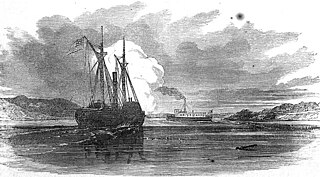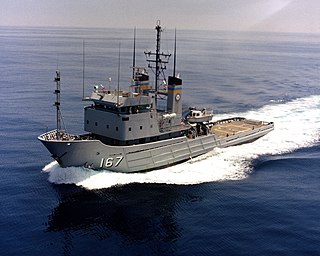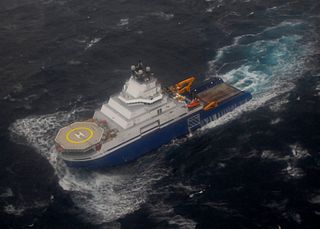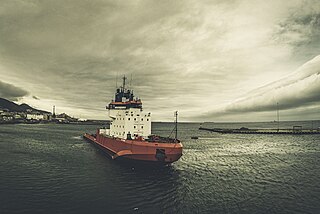
A tugboat or tug is a marine vessel that manoeuvres other vessels by pushing or pulling them, with direct contact or a tow line. These boats typically tug ships in circumstances where they cannot or should not move under their own power, such as in crowded harbors or narrow canals, or cannot move at all, such as barges, disabled ships, log rafts, or oil platforms. Some are ocean-going, and some are icebreakers or salvage tugs. Early models were powered by steam engines, which were later superseded by diesel engines. Many have deluge gun water jets, which help in firefighting, especially in harbours.

A salvage tug, also known historically as a wrecking tug, is a specialized type of tugboat that is used to rescue ships that are in distress or in danger of sinking, or to salvage ships that have already sunk or run aground.

MVNew Carissa was a freighter that ran aground and broke apart on a beach near Coos Bay, Oregon, United States, during a storm in February 1999. An attempt to tow the bow section of the ship out to sea failed when the tow line broke, and the bow was grounded again. Eventually, the bow was successfully towed out to sea and sunk. The stern section remained on the beach for over nine years until it was dismantled and removed in 2008.
Ryan Leet is an ocean-going salvage/supply tugboat. The tugboat is owned and operated by Offshore Marine Supply Services Inc. Justin Beaune its registered director and owner. The vessel is based in Panama, and operating in the Caribbean. As of 2022 she is used for towing of ships and barges, supply, ship-to-ship fuel transfers and fire and rescue.
The Santa Fe Railroad tugboats were used by the Atchison, Topeka and Santa Fe Railway to barge rail cars across the San Francisco Bay for much of the 20th century, as there is no direct rail link to the San Francisco peninsula. In the post World War II period, a fleet of three tugs moved the barges: the Paul P. Hastings, the Edward J. Engel, and the John R. Hayden. After cross-bay float service had ended and the tugs had been sold, the Hastings sank off Point Arena, California in 1992, in water too deep to raise. The Engel sank off Alameda, California in 2007 and was raised and scrapped in the winter of 2013-14. The Hayden remains afloat and in service in Oregon.

Luna is a historic tugboat normally berthed in Boston Harbor, Massachusetts. Luna was designed in 1930 by John G. Alden and built by M.M. Davis and Bethlehem Steel. She is listed on the National Register of Historic Places and is a U.S. National Historic Landmark. In 1985, the Luna was designated as a Boston Landmark by the Boston Landmarks Commission.

USNS Narragansett (T-ATF-167) is a Powhatan-class fleet ocean tugboat of the US Navy. She was launched in 1979 and inactivated in 1999, but has since been employed in a number of roles. She is still in service as of 2023 as a training support vessel for Carrier Strike Group 4.

USNS Powhatan (T-ATF-166) was the lead ship of the United States Navy Powhatan-class fleet ocean tugboats. She was in service with the U.S. Navy from 1979 to 1999, and then was leased to a private towing and salvage company. At the end of the lease in 2008, the ship was sold to the Turkish Navy which recommissioned her as TCG Inebolu.

The Powhatan class of fleet ocean tugs consists of seven ships built for the United States Navy, and operated by the Military Sealift Command (MSC). The lead ship of the class was launched in 1978 and the last ship in MSC service will be deactivated in 2023. During their service life, the Powhatan's were the most powerful tugs owned by the Navy.
Herakles was a pusher vessel owned by Finnish towing and marine salvage company Alfons Håkans Oy Ab. The ship, originally built as salvage tug Into in 1967, was converted to a pusher in 1991 to be chartered to Rautaruukki Oyj and later ESL Shipping Ltd as the third pusher vessel for the Finnpusku system, a Finnish integrated tug and barge system built in the mid-80s.

Finnpusku is an integrated tug and barge system owned and operated by ESL Shipping, a Finnish shipping company that specializes in bulk cargo transports in the Baltic Sea. The system was developed in the 1980s by Finnlines, another Finnish shipping company that also managed the vessels until 2003, in co-operation with Rautaruukki to transport raw materials to the Raahe Steel Works. Two pushers and five barges, four of which remain in service, were delivered by Hollming in 1986–1987.

Aiviq is an American icebreaking anchor handling tug supply vessel (AHTS) built in 2012 to support oil exploration and drilling in the Chukchi Sea off Alaska. The vessel's primary task was towing and laying anchors for drilling rigs, and oil spill response. In December 2024, the USCG finalized the contract for the acquisition of Aiviq. After conversion, the vessel will be commissioned to USCG service as a medium icebreaker USCGC Storis.

MV Canadian Miner was a Canadian laker that was part of the fleet of Upper Lakes Shipping from 1994–2011. Initially constructed as Maplecliffe Hall in 1966, the ship was renamed Lemoyne in 1988 before becoming Canadian Miner in 1994. In 2011, the name was shortened to just Miner. In 2011 the vessel was taken out of service and sold for scrapping. While en route to the scrapyard in Turkey, the ship ran aground off Nova Scotia in 2011. The vessel was broken up in 2014 in Nova Scotia.

MSC Flaminia is a German container ship which caught fire on 14 July 2012, claiming three lives and forcing the crew to abandon ship in the middle of the Atlantic Ocean. After the fire had been brought under control, the stricken container ship was towed to Europe and arrived at Wilhelmshaven, Germany, on 9 September 2012. In March 2013, she departed Wilhelmshaven for Mangalia, Romania for repairs which were finished in July 2014. The ship is currently sailing under the name CMA CGM San Francisco.

Point Chebucto is a harbour tug that was built at the Halifax Shipyard in Halifax, Nova Scotia, Canada in 1992. She was christened in January of 1993 by Mrs. Joyce Watson, wife of Cpt. David A. Watson. She is one of very few harbour tugs that were built at the Halifax Shipyards. She has been aiding ships in and out of Halifax Harbour and later Port Hawkesbury, Nova Scotia since she was registered in January 1993. The tug was built for Eastern Canada Towing Limited, a company that has been around for over 60 years. The tug is named after the point at Chebucto Head, continuing the tradition of Eastern Canada Towing of naming its tugs after points. Eastern Canada Towing took over Foundation Maritime's work in the field of Harbour, Coastal and Deep-Sea tow and salvage. The firm owns and operate a fleet of modern tugs ranging from 1250 HP - 5400 HP. Most tugs are ice strengthened, with several having Ice Class 1 certification. Their head office is also in Halifax. Eastern Canada Towing was purchased in 2007 by Svitzer, a tug boat division of Maersk.

MOL Comfort was a 2008-built Bahamian-flagged post-Panamax container ship chartered by Mitsui O.S.K. Lines. The vessel was launched in 2008 as APL Russia and sailed under that name until 2012, when the ship was renamed to MOL Comfort. On 17 June 2013, she broke in two about 200 nautical miles off the coast of Yemen. The aft section sank on 27 June and the bow section, after being destroyed by fire, on 11 July.

Seaforth Channel is a channel in the Central Coast region of the Canadian province of British Columbia which is part of the Inside Passage - the 950 miles (1,530 km) passage between Seattle, Washington and Juneau, Alaska. The marine highway goes through Seaforth Channel on the way to Milbanke Sound, one of the open sea portions of the Inland Passage. Seaforth Channel which is part of the Prince Rupert/Port Hardy BC ferry route, extends in a westerly direction from Denny Island to Milbanke Sound between Denny Island, Campbell Island and the Wright group of islands on the south. In October 2016, a Texas-owned tug/barge transiting the Canadian waters of the Inside Passage without a local pilot was hard grounded on a reef at the entrance to Seaforth Channel in October 2016. More than 100,000 L of fuel contaminated the coast, coves and shores 20 km (12 mi) west of Bella Bella, the core community of the Heiltsuk Nation as well as the environmentally sensitive Great Bear Rainforest - Canada's contribution to the Queen's Commonwealth Canopy (QCC), a network of forest conservation programs. Clean up response and salvage was criticized by the Heiltsuk, B.C. Premier Christy Clark and Prime Minister Justin Trudeau. In November in Vancouver the Prime Minister announced a $1.5B ocean protection plan to "create a marine safety system, restore marine ecosystems and undertake research into oil spill cleanup methods."
MV Flevoborg is a cargo ship registered in the Netherlands and operated by Wagenborg. Completed in 2010, Flevoborg ran aground in the St. Lawrence River off Sainte-Croix, Quebec in 2017.

Kigoriak was a Canadian and later Russian icebreaking anchor handling tug supply vessel. Built by Saint John Shipbuilding & Dry Dock Company for Canadian Marine Drilling (Canmar) in 1979 as Canmar Kigoriak, she was the first commercial icebreaking vessel developed to support offshore oil exploration in the Beaufort Sea.

Sea Victory was an ocean-going tugboat. She is best known for her long-distance tows of several of the U.S. Navy's most celebrated and historic vessels. For much of her career she was one of the most powerful American-flagged tugs, which earned her major jobs that could not be completed by smaller vessels. She was launched in 1974 and scrapped, likely in 2023.

















